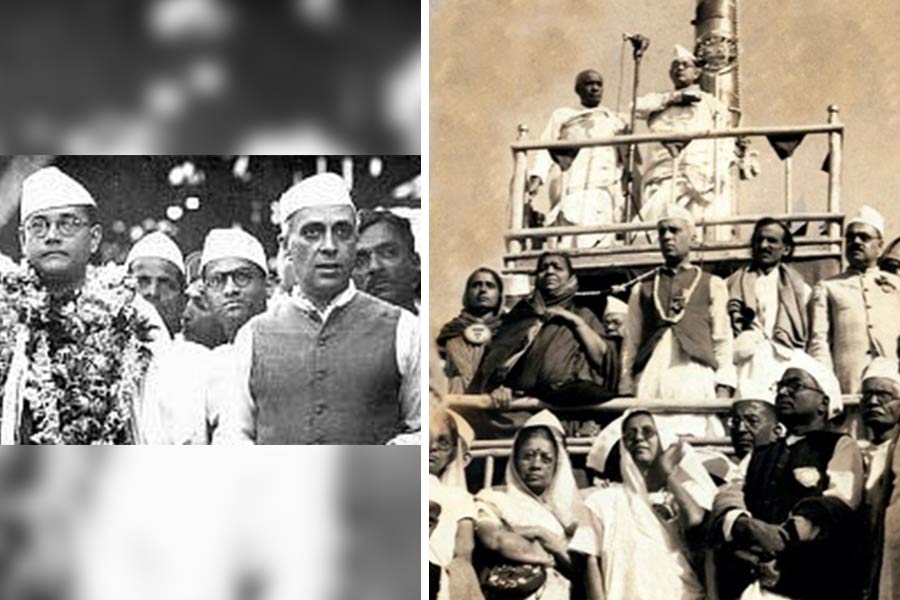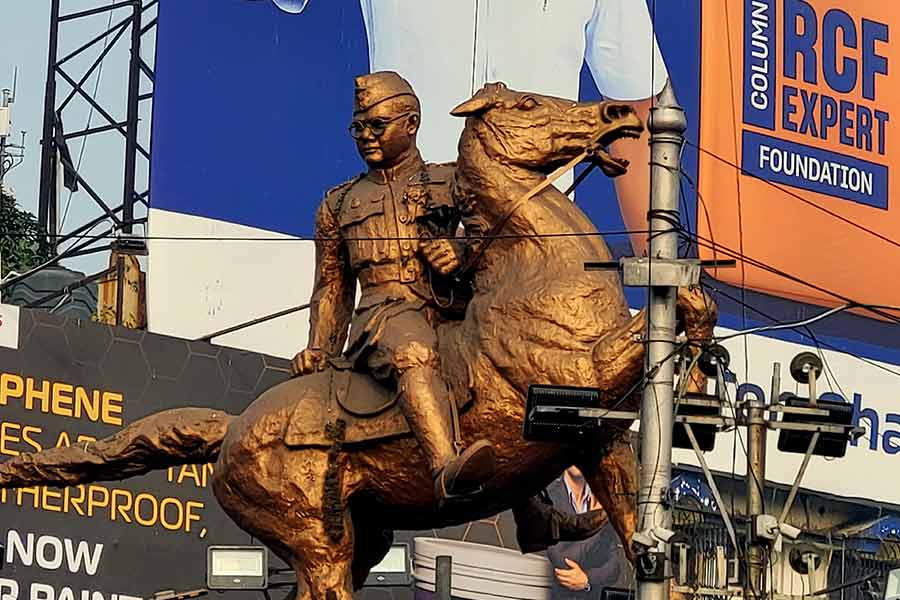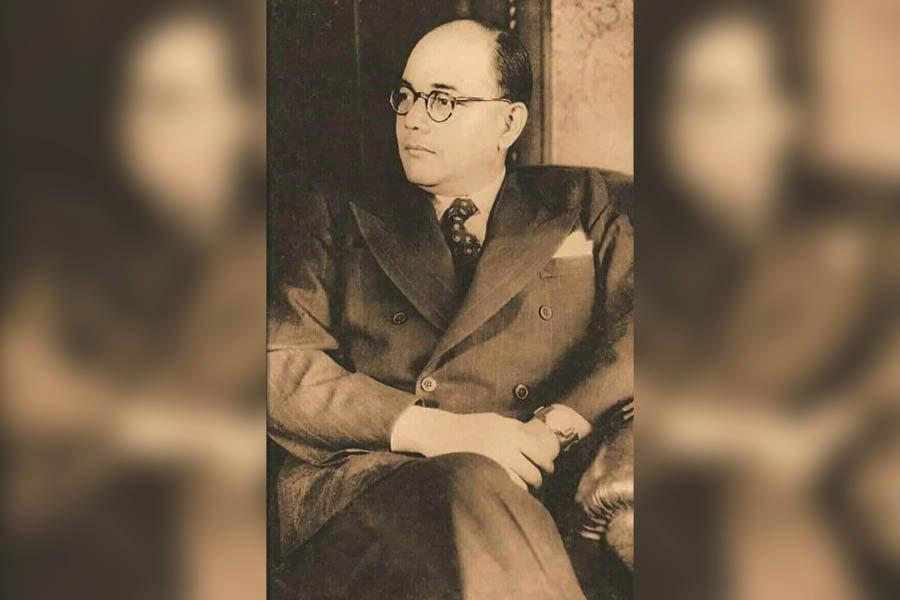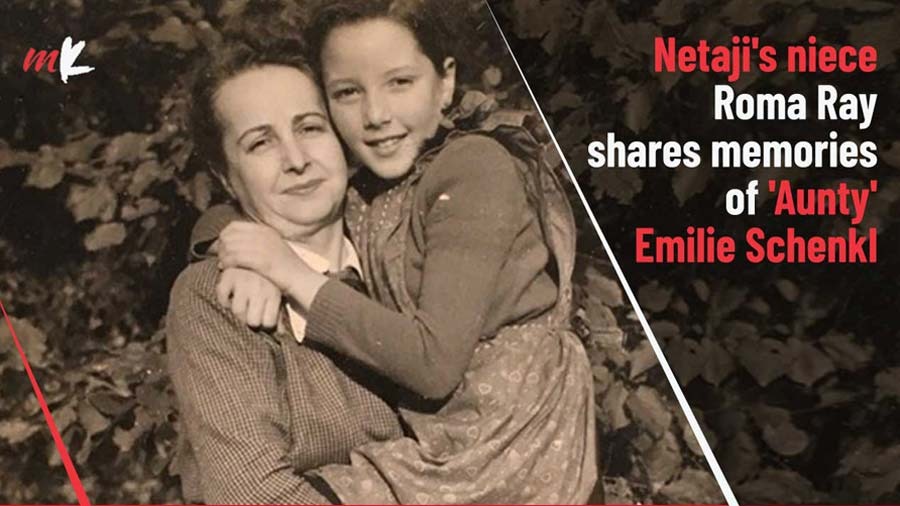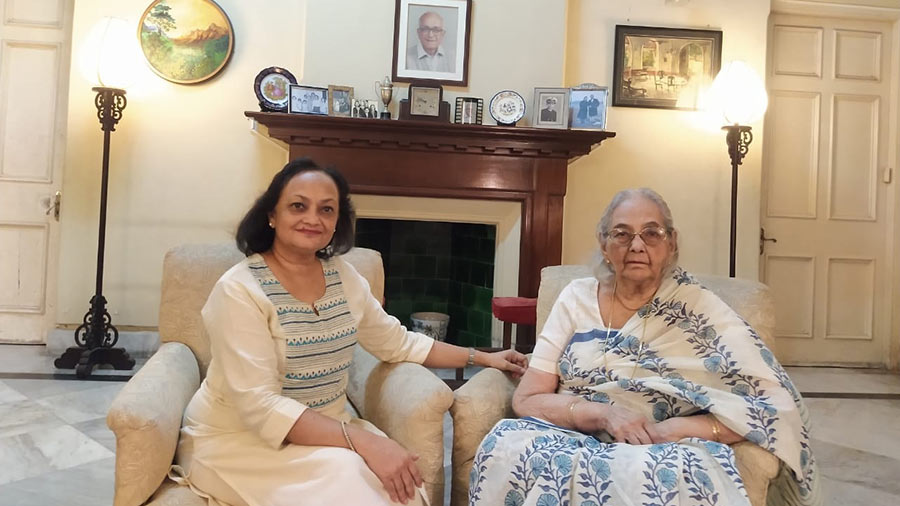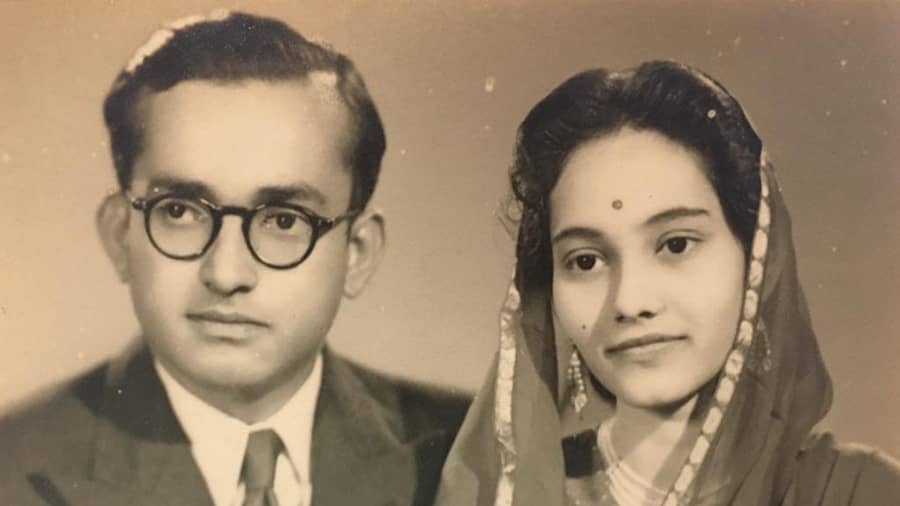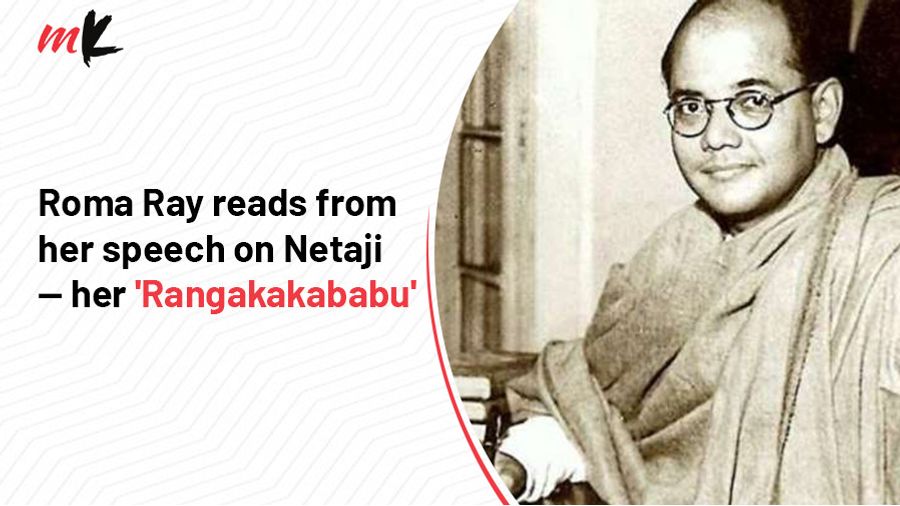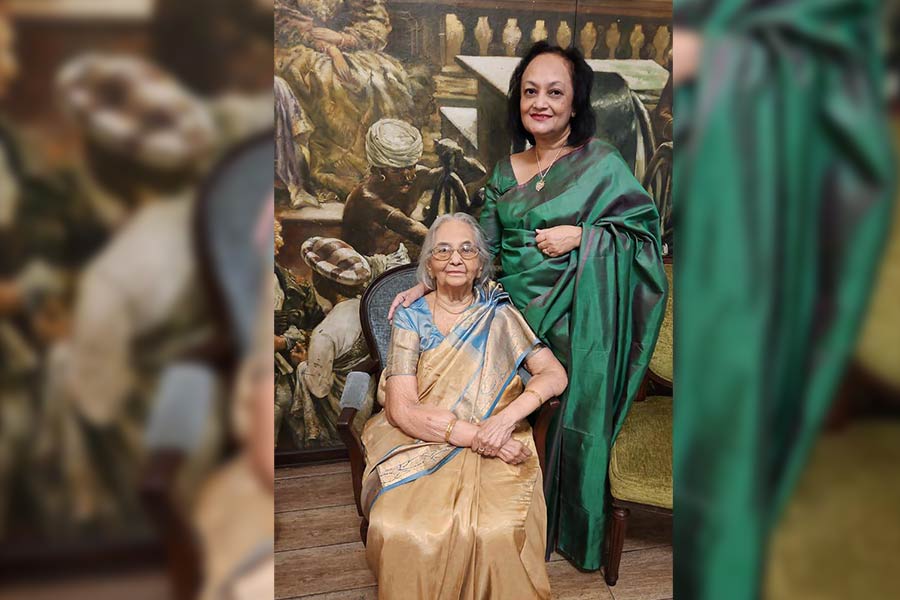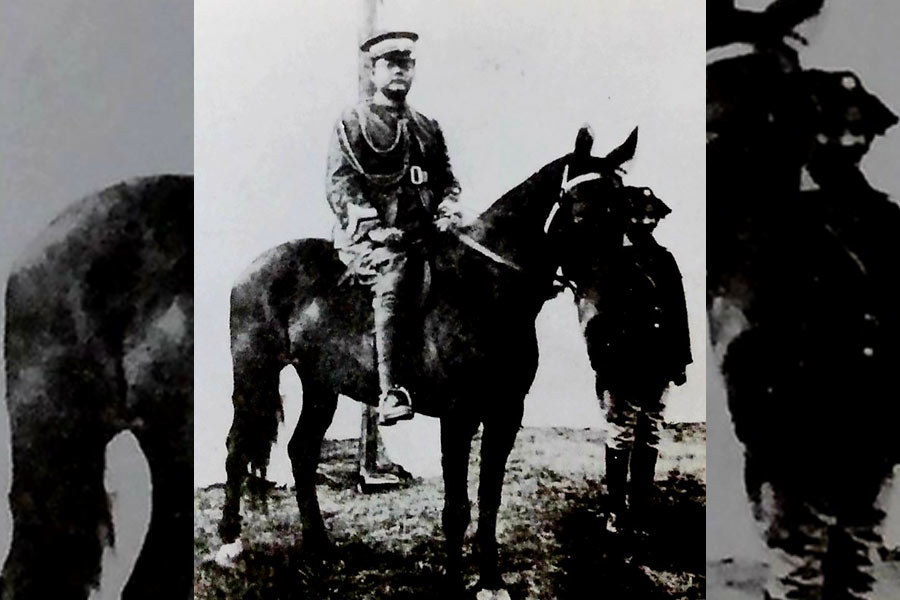In January, 1997, when India was celebrating birth centenary of Netaji Subhas Chandra Bose, Bishen Kumar, a young reporter of The Indian Express visited a non-descriptive village near Surat in Gujarat to talk to elderly villagers who were witness to an event 59 years ago.
The reporter was startled to discover that the seniors could still vividly recall a grand procession of a tall leader, whom they lovingly called ‘Subhas Babu’, passing through the dusty lanes of their village in February, 1938.
An old Rambhai Patel stepped forward to claim that he was the man who drove Subhas Babu’s royal chariot, which was lent by Maharaja Shri Indrasinhji Pratapsinhji of Vansda state. Dahya Bhai N. Patel recalled how as a boy of 19 years, he had waited for hours to catch a glimpse of Subhas Babu and his grand procession that traversed 3km through their village to the Congress city built on the banks of the Tapti.
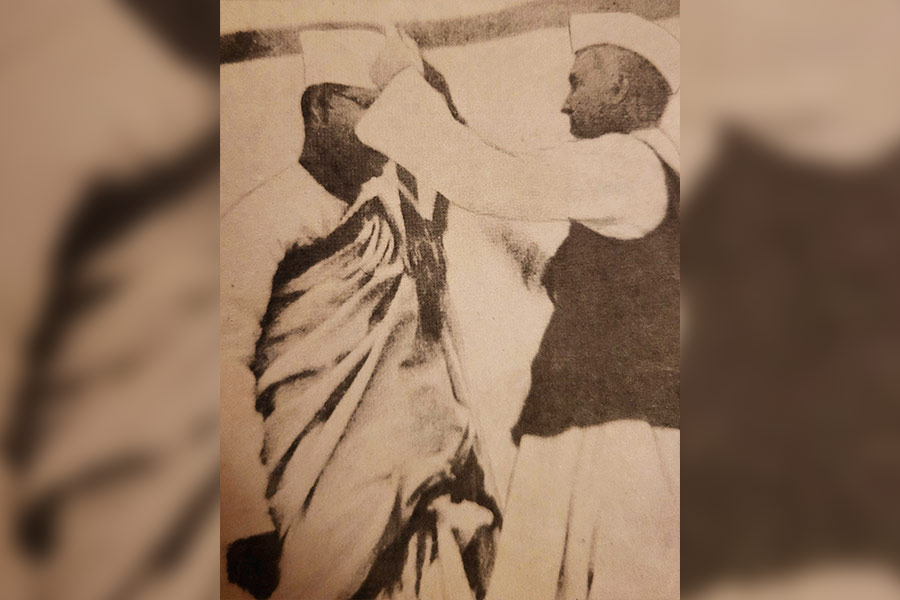
Nehru passes the presidential medal to Bose at the Congress township in Haripura
One Ratnaben recalled how she was inspired to see that the great leader of Bengal to join the freedom struggle and undergo a three-month imprisonment. She recalled how every single girl and woman of the village cheered and showered flowers on the leader from the rooftops.
From mid-1937, Gandhi and his very close disciples made it clear that Subhas Chandra Bose, the young firebrand leader from Bengal, will be the next president of Congress. Gandhi, who made Jawaharlal Nehru Congress president for 1936 and 1937, was sure that by offering the coveted post to Bose, he will be able to tame the Left-leaning camp of his party. But from the working committee to organisational control, everything will be in his own hands through Patel, JB Kripalini, Rajendra Prasad, Maulana Azad, Jamnalal Bajaj, Bhulabhai Desai, Rajagopalachari.

Bose departs from Howrah station for Haripura and (right) on his way to the station from Elgin Road
Though Gandhi was confident that Bose was less dependable and less amendable in comparison to Nehru, he still wanted to give Bose a chance after much debate with Kripalini and Patel. However, Nehru and entire Left-leaning socialists like Jaiprakash Narayan, Minu Masani, MN Roy, Narendra Dev, Ram Manohar Lohia etc were overjoyed to see Bose as Congress president, a post that no Bengali ever got after Chittaranjan Das in 1922.
On January 18, 1938, when Bose was in London after 16 long years, Acharya Kripalini officially announced in India that Subhas, who was just a few days away from his 41st birthday, would be the next president of Congress in its impending 51st session in Gujarat’s Haripura village. It created a sensation across India and also in England that a bitter critic of Gandhi and a soft admirer of some European dictators would now get the highest political post that an Indian could reach in that era.
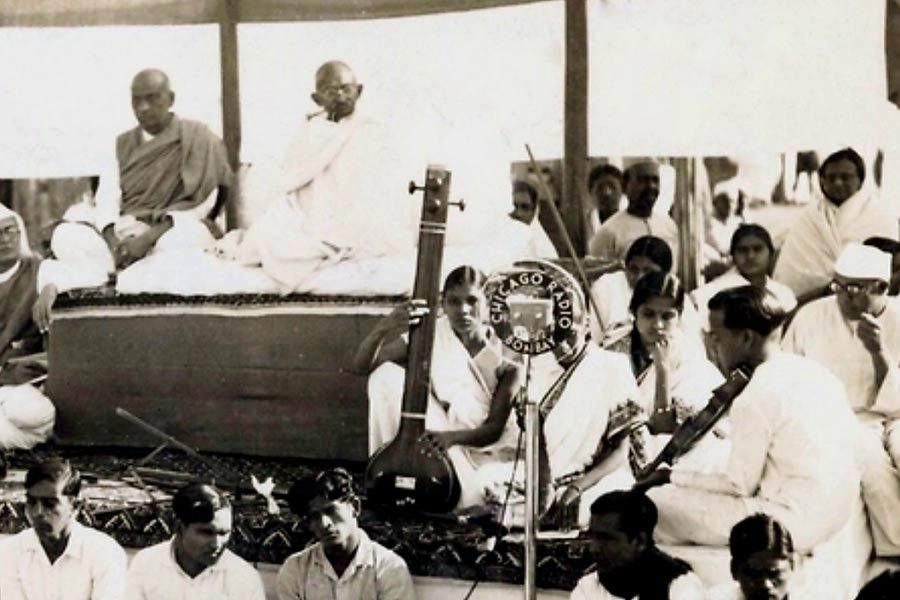
Gandhi and Patel at a musical function during the Haripura Congress session
Bose then in London was calm but strong with his typical anti-British stand and the Time magazine quoted him as saying “Britain has ruined India economically, politically, culturally and spiritually”.
The newly married Bose left Europe by touching few more countries and landed in India on January 24, 1938. He got hardly a few days to write his presidential speech at his 38/2 Elgin Road residence, which was then properly typed and vividly checked by Nirad C. Chaudhuri, the talented personal secretary of his elder brother Sarat Bose.
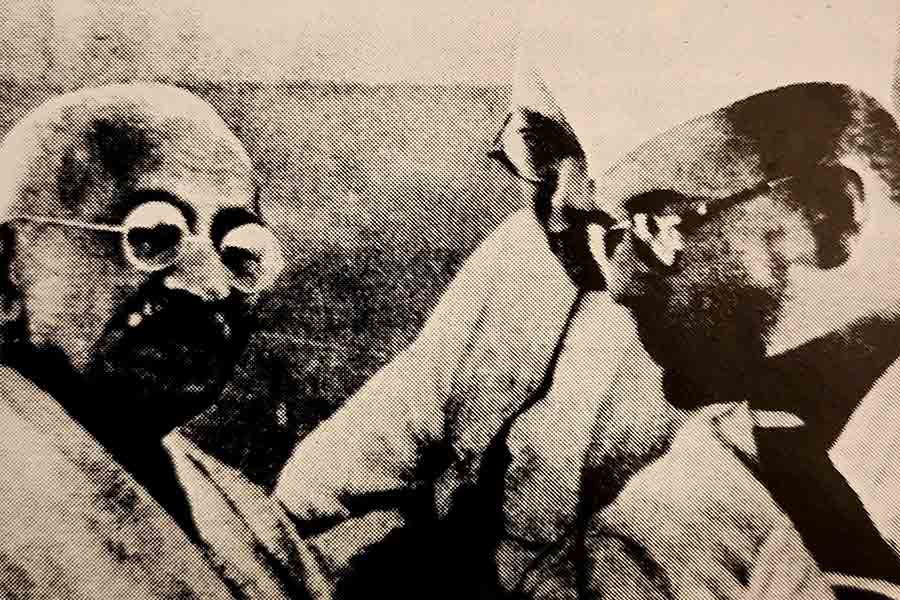
Mahatma Gandhi and Subhas Chandra Bose interact during the session
On February 11, 1938, Bose, with a Hindi teacher and with a big gang of relatives, which included his mother, few elder brothers, nephews among others boarded a second-class compartment of Bombay Mail from Howrah station. He was accompanied by 62 members of the Bengal Pradesh Congress Committee who joined later.
The roads from his home to the station were lined up by people wishing the new Bengali ‘rashtrapati’ (president), who was going to become the youngest president in the history of the Congress party. The air at Howrah station rent with slogans like “Subhas Chandra, zindabad” and “Vande Mataram”.

Bose delivers the presidential speech at Haripura
Gandhi made it clear to Patel that the Haripura session of the Congress must be on a giant scale and the welcome accorded to Bose must be the grandest ever. Patel, a son of Gujarat and also a leader of Bardoli, entrusted the chairmanship of the reception committee to one Durbar Gopaldas.
The Congress city was made to accommodate nearly 50,000 delegates to stay for nearly a week and to host nearly 2,00,000 party workers in an amphitheater for various open sessions.
Gandhi asked Nandalal Bose of Santiniketan to decorate every single corner of the Congress city using village handicrafts. At the Faizpur Congress session in 1937, Nandalal had created a similar township on Gandhi’s request.
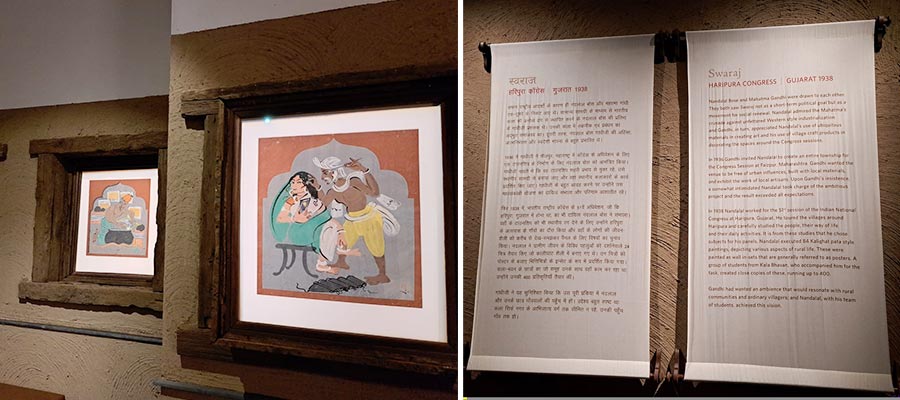
Paintings for the Haripura Congress session by students of Nandalal Bose in the (right) gallery of Modern Art in Delhi
In 1938, the project was much bigger for both Durbar Gopaldas and Nandalal Bose. They started creating a massive temporary township nearly three months in advance, with 10,000 workers. In November 1937, Tapti flooded the venue and the land meant for township remained under water for six weeks. Nandalal found bamboos near the spot and decided to make most of the structure in bamboo, cane, wooden rafters and date mats among other things.
Once the basic structure was complete, Nandalal employed a large group of his students from Santiniketan who toured various villages in Gujarat and studied the rural lives. They were asked to create nearly 84 Kalighat patachitra-styled paintings expressing an ambience that resonate with rural communities and villagers.
The township was named Vitthalnagar and was equipped with running water, underground drainage, electricity, telephone lines, telegraph facilities and even with a temporary post office service. There was ample provision of food along with a cowshed of 500 cattle heads to supply fresh milk to all.
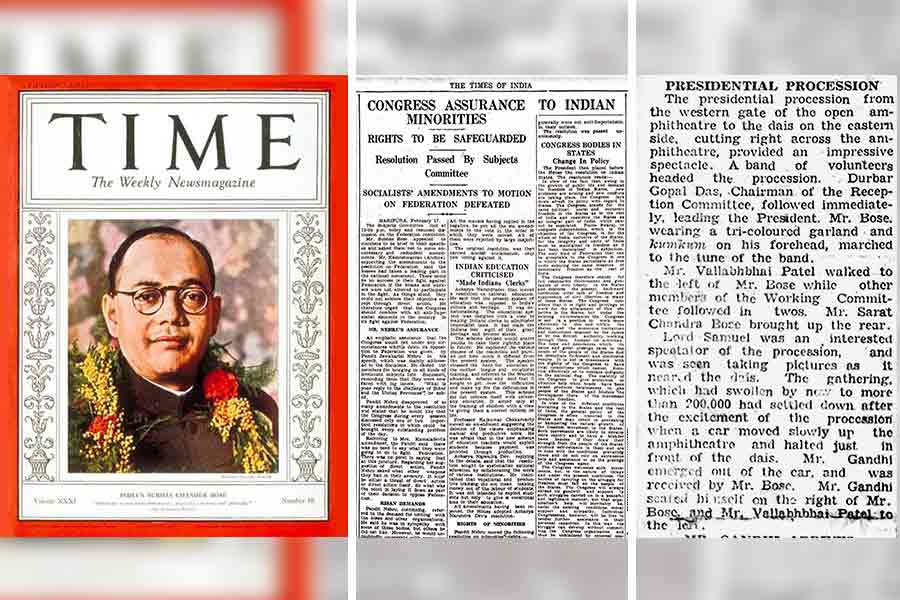
(From left) Bose on the cover of the American ‘Time’ magazine, a report published in ‘The Times of India’ and a report on the presidential procession
Bose with his team arrived at Bardoli station on February 19, where a large number of Congress workers received him. Vallabbhai Patel and Durbar Gopaldas were present at the platform. Patel tightly hugged Bose, while Gopaldas garlanded him amid roaring cheers of “Subhas babu ki jai”.
From the station, Bose was taken in a car to the edge of Haripura village where a mammoth presidential procession was waiting to take Bose to the Congress township. The procession included 51 brightly decorated bullock carts drawn by decorated bulls. A special brass bell with Vande Mataram engraved on it was hung from the neck of each bull. The brass bell soon became a coveted collectable and famous vexillologist Shekhar Chakraborty is one who proudly owns one such bail.
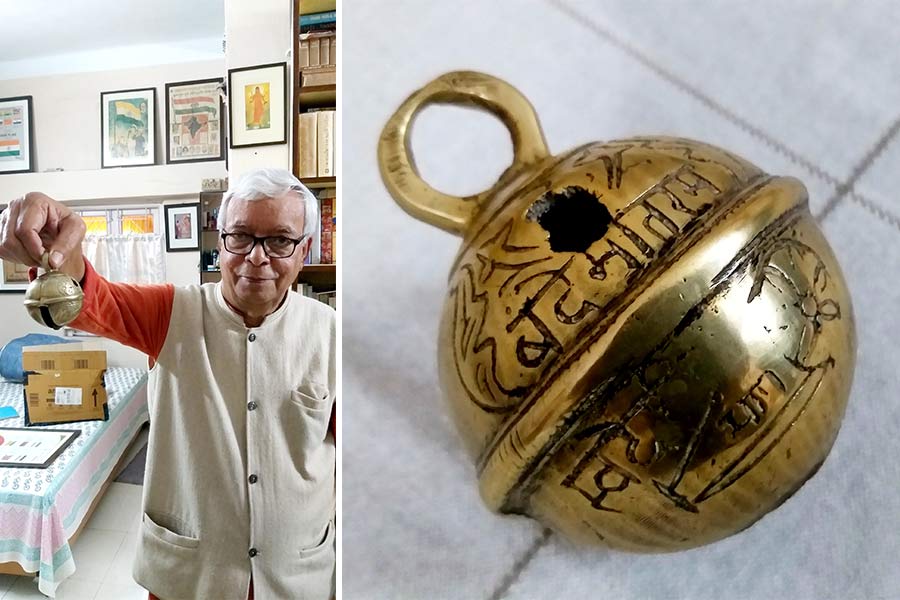
Collector Shekhar Chakraborty shows off one of the commemorative metal neck bells of the bullocks from the Haripura Congress session
A special chariot was arranged for Bose and Ford company provided a car for his use. The grand procession passed the dusty lanes and bylanes of Haripura village. It passed under 51 extraordinarily decorated gates and 51 patriotic songs in various language were sung. Apart from common people, delegates and Congress workers there were dhol players, lezim (folk dance and physical exercise from Maharashtra) dancers, marshall artists, instrument players, band parties, folk dancers and singers from Gujarat and Rajasthan who performed in the moving procession till the time it reached the main amphitheatre complex.
The number of female volunteers in the procession was significant and they all were under the leadership of Mridula Sarabhai. There were array of shops and exhibition pavilion showcasing musical performances. Many competitions were arranged to keep up a festive mood. In the spinning competition, a young lady named Girija from Salvi Maharashtra won first prize and her husband Jairam won the second prize. Sardar Patel handed over the prizes to the winners, while Gandhiji apart from joining many meetings, took his time off to watch a few musical performances.
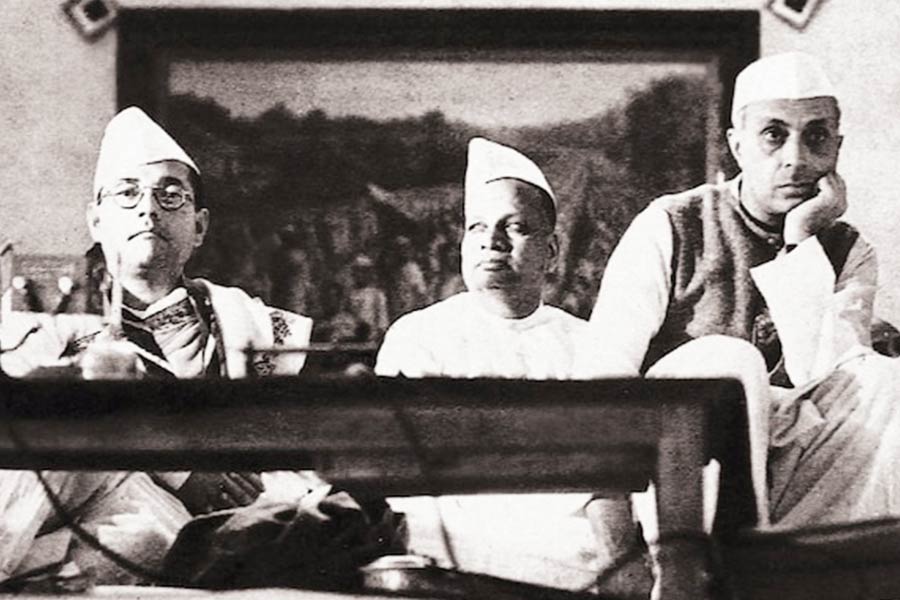
Leaders at the Haripura subject committee meeting in 1938
The procession first stopped at centre of the village named ‘padar’ where the air was warm with unlimited love and respect for Subhas Babu by people who were waiting since morning to see the prince of all patriots. It again stopped at Jhanda pole or the flag square where Bose hoisted the Congress flag. Nehru received Bose near the erected stage of the presidential address. As an outgoing president, he passed the metal medal of presidentship to Bose. By then, all top leaders like Kripalini, Sarojini Naidu, Patel, Maulana Azad and Gandhiji joined the meeting. Reputable Marathi literary figure from Bombay Pandit B Laxminarayan Sanbhoge recited a Sanskrit poem titled “Sri Subhash Chandra Prashasti”.
At the beginning, Durbar Gopaldas on behalf of Gujarat, welcomed all delegates coming from various parts of India. After Nehru officially handed over the onus, Bose took up the microphone. He donned a white Gandhi cap and his signature round pair of spectacles. The Times of India dated February 21, 1938, described the handsome look of Bose by saying “President Mr Bose wearing a Tricolour garland and kumkum on his forehead marched to the tune of the band”.
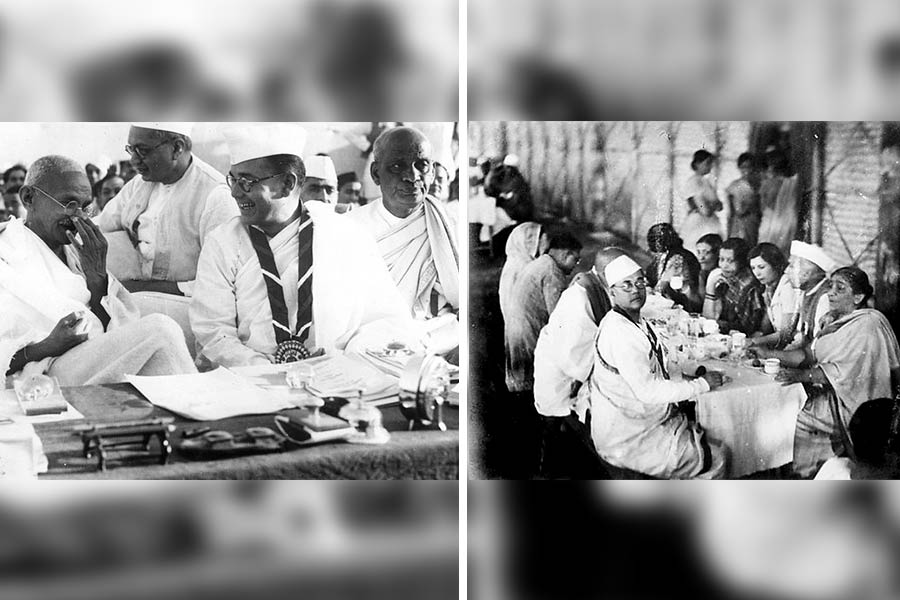
Bose with Gandhi and Patel and (right) enjoys tea with Sarojini Naidu
This session of Congress was widely covered by the print and mass communication media. Apart from reporters from all major newspapers of India, it had attendees like Lord Samuel of England, a delegation from South Africa and even the Prime Minister of Ceylon. American weekly magazine Time covered the event and they made it their cover story in their 7th March 1938 issue with picture of Bose.
The presidential speech of Bose was very long and it took nearly three hours to complete. Bose delivered his speech in English. He in other meetings of the session spoken in Hindi and English.
Bose began his speech showing respect to Gandhi and soon made very clear that though India’s struggle of freedom was non-violent in nature but even a non-violent movement needs an army, an organisation and a machinery. Bose warned India of population explosion and made it clear that Hindustani written in Roman script will be its national language.
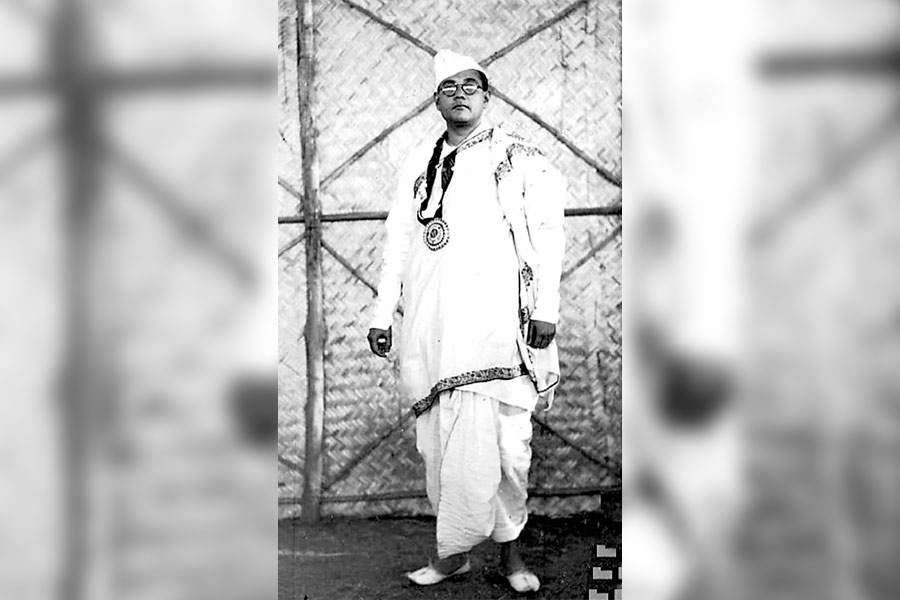
Netaji stands tall at the Haripura session in Gujarat
He quoted Lenin and praised the Communist Party of Great Britain for their pro-India stand. Bose from Haripura announced the formation of a National Planning Commission. He mentioned the political tumult of Europe and emphasised that India must take this chance to give a strongest push to Britain to gain her freedom as soon as possible.
Bose disapproved any participation of Indians in the impending war. He indicated a future India with huge industrialisation and talked on good relations with all countries, including Great Britain, after Independence. The presidential speech delivered by Bose in 1938 was most detailed and vivid by any standard. His speech was loudly cheered by the masses.
The Haripura session was between February 19 and 22and in the next few days, Bose attended several sessions in which all top leaders of the Congress were present and played active roles. In Haripura, Japan was condemned for attacking China and there was a call to boycott Japanese products. From here, Bose after receiving proposals from Maharashtra, Tamil Nadu, Delhi and Central province, announced that the next Congress session will be held in Mahakoshal in the Central Province.
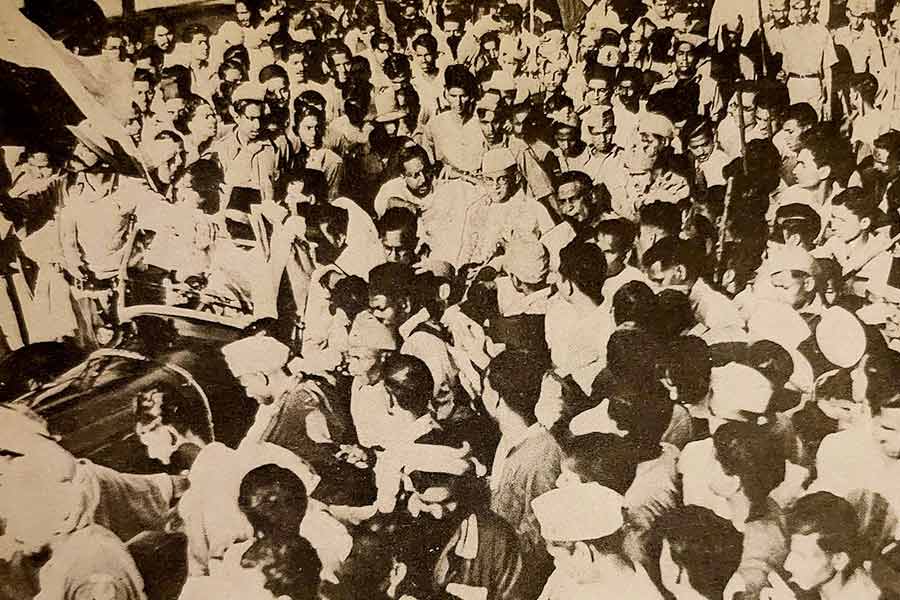
Bose returns to Calcutta from Haripura in March, 1938
At last, Bose, as the new president, made his own working committee where he failed to include many people of his choice. Except Nehru, Sarat Bose and himself, Bose included all so-called Gandhi camp people like Rajendra Prasad, Kripalini, Azad, Jamnalal Bajaj, Rajagopalachari, Patel and Sarojini Naidu among others. Though he had very cordial relations with Congress Socialist Party, he could include neither Minu Masani nor Jaya Prakash Narayan in the working committee.
In the Haripura session, there was an open conflict of opinion between the right and left groups of Congress. Bose communicated to Kripalini to shift the All India Congress party office from Allahabad to Calcutta, which upset Kripalini.
The Haripura congress was a great roadshow carried out by Patel under Gandhi’s instructions. Bose cemented himself in the big national political spectrum and became a dream leader forever in eyes of common people.
Bose never returned to Haripura but his unimaginable actions in Europe and South Asia from 1941 to 1945 as a warrior leading an Indian army to uproot the mighty British and his enormous sacrifices turned him into a legend.
